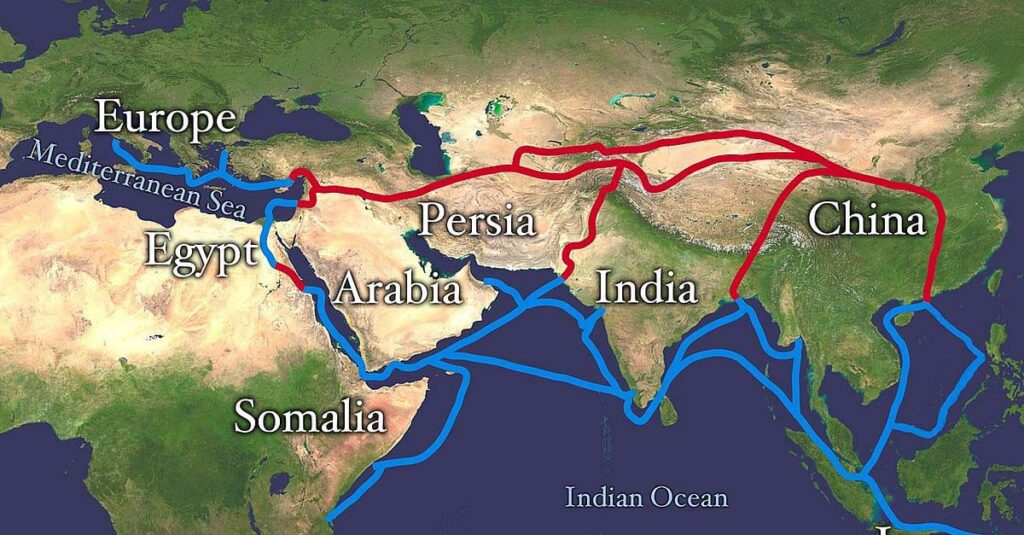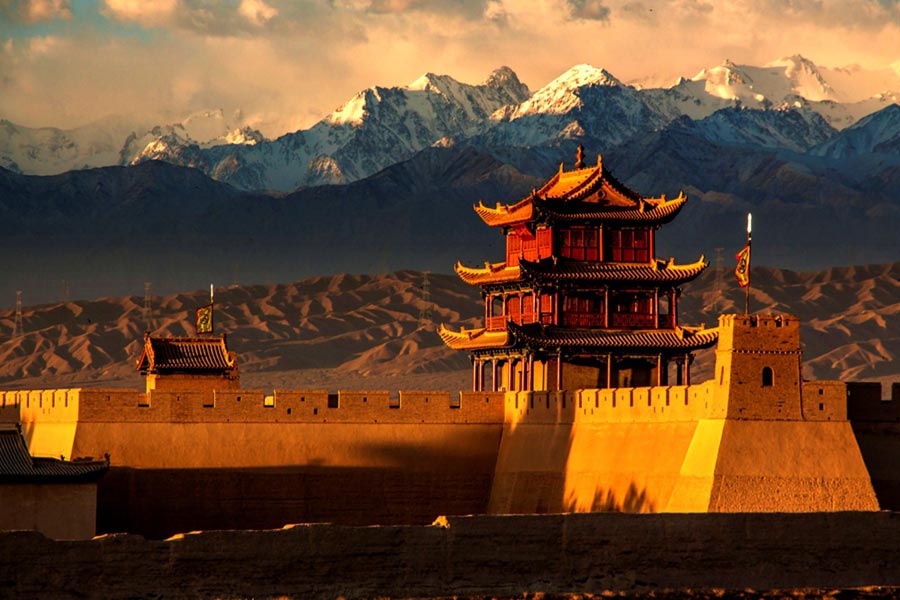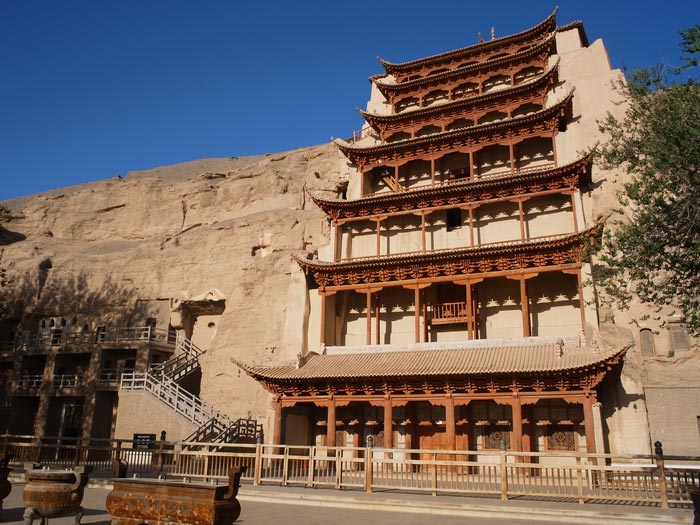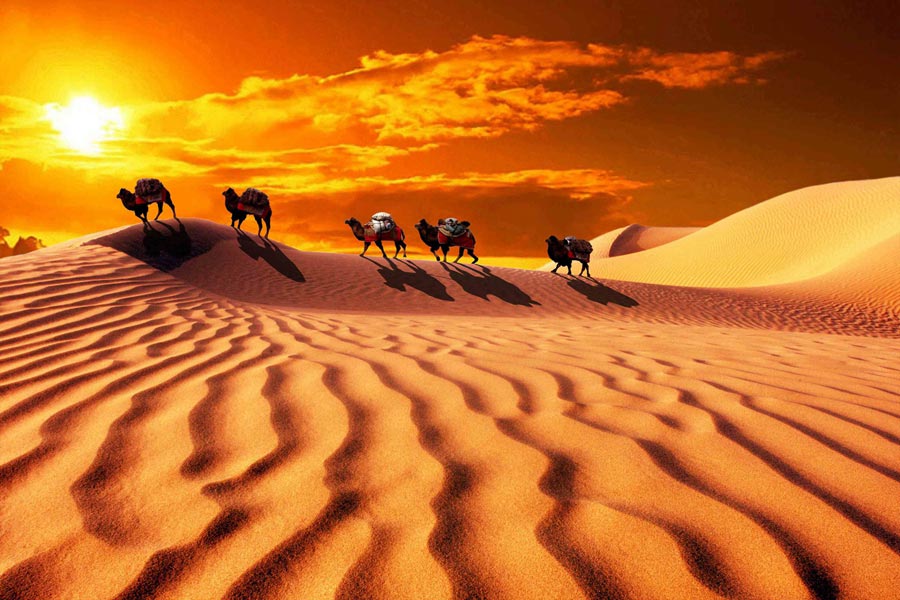The Silk Road, also called Silk Routes, was a general name for the ancient strategic transportation channel which started from China and passed through Central Asia, West Asia, Africa and Europe. In the 19th century, when the name Silk Road was first used by a German geographer, it just included the land road from China’s Xinjiang to Central Asia. Later it expanded gradually and reached West Asia, Europe and Africa. It took land and water routes. It is not only an important route connecting the ancient world, but also a synonym for economic and cultural exchanges between the western world and the oriental world.
Early History of the Silk Road
The Silk Road was an international passage with historical significance. The ancient Silk Road helped to integrate the old Chinese, Indian, Persian, Arabian, ancient Greek, and Roman cultures and promote the exchange of the Occidental and Oriental civilizations.
Zhang Qian of the Han Dynasty is the first diplomat who led a diplomatic mission to Xiyu (ancient Xinjiang). He traveled the road and took gold and silk products there between 139 BC and 138 BC. His assistants visited Anxi (now Iran), India and a number of other countries. These countries and regions in turn also sent diplomatic missions to China, which brought a busy trade to Xinjiang. Ancient central China’s silk products, ironware, gold, bronze mirror, bamboo work, medicine, and farming techniques were introduced to Xiyu (ancient Xinjiang), India and Europe. And grape, flax, walnut, cucumber, elephant, camel and houses and some other plants and animals were taken to central China at that time.
Ban Chao and his assistant Gan Ying are the other two diplomats sent to Xiyu by the Han government. They led a diplomatic mission of 36 people and arrived at Xiyu and Daqin (ancient Rome) on the Persian Gulf. India’s famous monk also came to central China’s Henan through Pakistan and Afghanistan in 147 and 401 respectively, to translate Buddhist Scriptures and enroll thousands of disciples. Chinese high-ranking monk Xuan Zang in the Tang Dynasty visited India and dozens of other countries and did missionary work in these countries along the Silk Road.

Marco Polo and the silk road
Another historic person worth mentioning here is Italy’s famous adventurer Marco Polo (1254 -1324).
Marco Polo was an Italian trader and explorer who gained fame for his worldwide travels. He was one of the first Westerners to travel the Silk Road to China (which he called Cathay). The Polo party left Venice in 1271. They spent 17 years in China and left China in late 1290 or early 1291 and were back in Venice in 1292.
After returning to Europe, he wrote The Travels of Marco Polo, describing his traveling experiences. The book had been an authoritative book for those who studied history of China, especially the history of the Yuan Dynasty. Marco Polo went east to the capital of the Yuan Dynasty from Crimea along the Silk Road. In The Travel, Marco Polo recorded in detail what he saw in the Western Region and Persia, from custom and habit, dress, languages, etiquette, character, and script to how they were influenced by the oriental Empire. Marco Polo arrived at Dadu (the Capital of the Yuan Dynasty) in 1275, approximately 30 years after the Mongolian army in Europe. Despite the attempt of Yuan Taizu to turn the whole world into grassland for tending the animals, the Mongolians left nothing but dreadful memory in Europe. It seems that conquest by armed forces is not as effective as civilization. Marco Polo was surprised that even in Yuan Dynasty, the countries of the Western Region should retain the ancient oriental civilization of several hundred years ago. Though Tang Dynasty had fallen for nearly 500 to 600 years, its influence and prestige, through the Silk Road, on West Asia, Mid-Asia and Europe still remained.
Europe’s Fascination with Silk
In only a few decades all the ruling families of Rome were anxious to attire themselves in silk. By 14 AD, silk had gotten so out of hand that Emperor Tiberius, disgusted by the revelatory bulges of this light and delicate fabric, forbade all men from wearing it. Before long the mystery of silk’s manufacture sucked Rome’s intellectuals into a blazing fervor. Pliny affirmed that “Silk was obtained by removing the down from the leaves with the help of water”. Others countered that it grew like wood in the forest.
Despite the foment of wild curiosity of its customers, the prudent merchants of China made every effort to keep silk’s manufacture a secret. It was limited to the far-off hinterlands of Sichuan, away from the prying eyes and the“big noses” of venturesome foreigners. Border guards, placed on high alert, double-checked all foreigners’ belongings.
A legion of stories of silk smuggling spread far and wide. The most romantic involves a young Chinese princess anxious to please her betrothed, the King of Yutian. When the King’s envoy revealed to her his master’s passion for silk, the princess resolved to smuggle the secret of silk to him. A few days later the princess set off in a glittering cavalcade on her long journey westwards. Many days later, when they reached China’s border at Dunhuang’s Yumen Gate, her party was thoroughly inspected. Even the princess’s personal belongings were closely scrutinized, much to the displeasure of the king’s envoy. After passing through the border gate, he approached the princess to inquire if she had succeeded in satiating his King’s love of silk. Removing her crown, the princess revealed silk worms hidden in her hair. She showed him the mulberry seeds she had hidden in plain sight among her medicines. Pointing at her serving maids, she revealed that, “all women in the Central Plains know how to grow mulberry seeds and rear silkworms.” Thus, the secret of silk escaped the confines of China.
The Nature of the Route
The description of this route to the west as the “Silk Road” is somewhat misleading. Firstly, although the route started from the capital in Chang’an, there are many branches. The northern route then passed through Yumen Guan (Jade Gate Pass) and crossed the neck of the Gobi desert to Hami. The southern route branched off at Dunhuang, passing through the Yang Guan and skirting the southern edges of the desert, via Miran, Hetian and Shache, finally turning north again to meet the other route at Kashgar.
Secondly, the Silk Road was not a trade route that existed solely for the purpose of trading in silk; many other commodities were also traded, from gold and ivory to exotic animals and plants. Of all the precious goods crossing this area, silk was perhaps the most remarkable for the people of the West. In addition to silk, the route carried many other precious commodities. Caravans heading towards China carried gold and other precious metals, ivory, precious stones, and glass, which were not manufactured in China until the 5th century. In the opposite direction furs, ceramics, jade, bronze objects, lacquer and iron were carried.
The Development of the Route
The development of these Central Asian trade routes caused some problems for the Han rulers in China. Bandits soon learned of the precious goods traveling up the Gansu Corridor and skirting the Taklimakan desert, and took advantage of the terrain to plunder these caravans. Caravans of goods needed their own defense forces, and this was an added cost for the merchants making the trip. This was partially overcome by building forts and defensive walls along part of the route. Sections of the “Great Wall” were built along the northern side of the Gansu Corridor, to try to prevent the Huns from harming the trade. Sections of the Han dynasty wall can still be seen as far as Yumen Guan. However, these fortifications were not all as effective as intended, as the Chinese lost control of sections of the route at regular intervals.
After the Western Han dynasty, successive dynasties brought more states under Chinese control. Settlements came and went, as they changed hands or lost importance due to a change in the routes. The Chinese garrison town of Loulan, for example, on the edge of the Lop Por Lake, was important in the 3rd century, but was abandoned when the Chinese lost control of the route for a period. Many settlements were buried during times of abandonment by the sands of the Taklimakan.

The settlements reflected the nature of the trade passing through the region. Silk, on its way to the west, often got no further than this region of Central Asia. The Astana tombs, where the nobles of Gaochang were buried, have turned up examples of silk cloth from China, as well as objects from as far afield as Persia and India. Much can be learned about the customs of the time from the objects found in these graves, and from the artwork of the time, which has been excellently preserved on the tomb walls, due to the extremely dry conditions.
The most significant commodity carried along this route was not silk, but religion. Buddhism came to China from India this way, along the northern branch of the route. The Eastern Han Emperor Mingdi is thought to have sent a representative to India to discover more about this strange faith. Further missions returned bearing scriptures and bringing with them, Indian priests. With this came influences from the Indian sub-continent, including Buddhist artwork. This was considerably influenced by the Himalayan Massif, an effective barrier between China and India, and hence Buddhism in China is effectively derived from the Gandhara culture by the bend in the Indus (a river in Northwestern India), rather than directly from India. Buddhism reached the pastures of Tibet at a rather late period, not developing fully until the 7th century. Along the way, it developed under many different influences, before reaching central China. This is displayed clearly in the artwork, where many of the cave paintings show people with clearly different ethnic backgrounds, rather than the expected Central and East Asian peoples.
The greatest flux of Buddhism into China occurred during the Northern Wei Dynasty, in the 4th and 5th centuries. This was at a time when China was divided into several different kingdoms, and the Northern Wei Dynasty had its capital in Datong in present-day Shanxi Province. The rulers encouraged the development of Buddhism, and more missions were sent toward India. The new religion spread slowly eastwards, through the oases surrounding the Taklimakan, encouraged by an increasing number of merchants, missionaries and pilgrims. Many of the local people adopted Buddhism as their own religion.
Some devotees were sufficiently inspired by the new ideas that they headed off in search of the source, towards India; others started to build monasteries and grottos. The development of the grotto is particularly interesting; the edges of the Taklimakan hide some of the best examples in the world. The hills surrounding the desert are mostly of sandstone, with any streams or rivers carving cliffs that can be relatively easily dug into; there was also no shortage of funds for the work, particularly from wealthy merchants, anxious to invoke protection or give thanks for a safe desert crossing. Gifts and donations of this kind were seen as an act of merit, which might enable the donor to escape rebirth into this world. In many of the murals, the donors themselves are depicted, often with a pious attitude. This explains why the Mogao grottos contain some of the best examples of Buddhist artwork.
The best-known caves are the Mogao grottos at Dunhuang, at the eastern end of the Taklimakan. It is here that the greatest number and some of the best examples are to be found. More is known about the origins of these, too, as large quantities of ancient documents have been found. These are on a wide range of subjects and include a large number of Buddhist scriptures in Chinese, Sanskrit, Tibetan, Uygur and other languages, some still unknown. There are documents from the other faiths that developed in the area and also some official documents and letters that reveal a lot about the system of government at the time.

The grotto building was not confined to the Taklimakan; there is a large cluster at Bamiyan in the Hindu Kush, in present-day Afghanistan. It is here that the second largest sculpture of Buddha in the world can be found, at 55 meters high.
For the archaeologist, these grottos are particularly valuable sources of information about the Silk Road. Along with the images of Buddhas, there are scenes of the everyday life of the people at the time. Scenes of celebration and dancing give an insight into local customs and costumes. The influences of the Silk Road traffic are therefore quite clear in the mix of cultures that appears on these murals on different dates. In particular, the development of Buddhism from the Indian style to a more individual faith is evident in studying the murals from different eras in any of the grotto clusters.
The Northern Wei Dynasty, which is perhaps the most responsible for the spread of Buddhism in China, started the construction of the Yungang grottos in northern Shanxi Province. When the capital of the Northern Wei was transferred to Luoyang, the artists and masons started building the Longmen grottos. These two more “Chinese” grottos emphasized carving and statuary rather than the delicate murals of the Taklimakan regions, and the figures are quite impressive in their size; the largest figure at Yungang measures more than 17 meters in height, second only in China to the great Leshan Buddha in Sichuan, which was constructed in the early 8th Century.
The Greatest Years of the Silk Road
The height of the importance of the Silk Road was during the Tang Dynasty, with relative internal stability in China after the divisions of the earlier dynasties since the Han. The individual states have mostly been assimilated, and the threats from marauding peoples were rather less. Chang’an, as the starting point of the route, as well as the capital of the dynasty, developed into one of the largest and most cosmopolitan cities of the time. By 742, the population had reached almost two million, and the city itself covered almost the same area as present-day Xi’an, considerably more than within the present walls of the city. The 754 censuses showed that five thousand foreigners lived in the city, like Turks, Iranians, Indians and others from along the Road, as well as Japanese, Koreans and Malays from the east. Many were missionaries, merchants or pilgrims, but every other occupation was also represented. Rare plants, medicines, spices and other goods from the west were to be found in the bazaars of the city. It is quite clear, however, despite the exotic imports, that the Chinese regarded all foreigners as barbarians; the gifts provided for the Emperors by foreign rulers were simply considered as tribute from vassal states.
During this period, in the 7th century, the Chinese traveler Xuan Zang crossed the region on his way to obtain Buddhist scriptures from India. He followed the northern branch on his outward journey, and the southern route on his return; he carefully recorded the cultures and styles of Buddhism along the way and brought back 600 scriptures from India. He is still seen by the Chinese as an important influence in the development of Buddhism in China.
The Decline of the Silk Road
Politically, when the Yuan Dynasty was replaced by the Ming Dynasty in 1368, the Ming Dynasty carried on the isolationist policies, these policies did nothing to encourage trade between China and the West. This attitude was maintained throughout the Ming and Qing Dynasties. Therefore, the barriers rose on the land route between East and West.
The decline of the Silk Road also owes much to the development of the silk route by sea. It was becoming rather easier and safer to transport goods by water rather than overland. Ships had become stronger and more reliable, and the route passed promising new markets in Southern Asia. The overland problems of “tribal politics” between the different peoples along the route prompted this move. In the early 15th century, the Chinese seafarer Zheng He commanded seven major maritime expeditions to Southeast Asia and India, and as far as Arabia and the east coast of Africa. Diplomatic relations were built with several countries along the route, and this increased the volume of trade Chinese merchants brought to the area.

